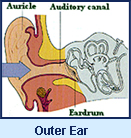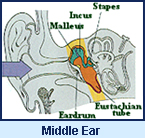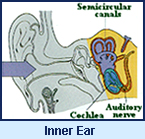How do we hear?
Sound is vibration that travels through the air and is sensed by the ear. The ear is a very complex organ comprising of three main parts: the outer ear, the middle ear and the inner ear. From the inner ear the auditory nerve transmits information to the brain for processing.
 Outer Ear: The outer ear consists of the pinna and the ear canal.The pinna is shaped like a hand cupped around the entrance to your ear. It is designed like this to improve how you collect sound coming from in front of you. The ear canal also helps you to hear certain sounds better. Our ears are best for hearing human speech. When there is a sound, air particles vibrate from the source all the way to the ear canal. When these air particles vibrate the ear drum, sound is sent to the middle ear.
Outer Ear: The outer ear consists of the pinna and the ear canal.The pinna is shaped like a hand cupped around the entrance to your ear. It is designed like this to improve how you collect sound coming from in front of you. The ear canal also helps you to hear certain sounds better. Our ears are best for hearing human speech. When there is a sound, air particles vibrate from the source all the way to the ear canal. When these air particles vibrate the ear drum, sound is sent to the middle ear.
 Middle Ear: The ear drum separates the ear canal from the middle ear space. The ear drum moves best if the air pressure inside the middle ear space is the same as in the ear canal. When there is less air pressure inside the middle ear than in the ear canal, the ear drum is pulled tight. This makes it had for the ear drum to move. A tube, called the Eustachian tube, runs from the middle ear to the throat. The Eustachian tube helps keep the pressure even between the ear canal and the middle ear. Chewing or swallowing can help to open this tube and make the pressure in these spaces equal again. The moving eardrum then moves a chain of 3 small bones, called the ossicles. All 3 of these bones can easily fit on one side of a penny. The third bone connects with the inner ear and the cochlea.
Middle Ear: The ear drum separates the ear canal from the middle ear space. The ear drum moves best if the air pressure inside the middle ear space is the same as in the ear canal. When there is less air pressure inside the middle ear than in the ear canal, the ear drum is pulled tight. This makes it had for the ear drum to move. A tube, called the Eustachian tube, runs from the middle ear to the throat. The Eustachian tube helps keep the pressure even between the ear canal and the middle ear. Chewing or swallowing can help to open this tube and make the pressure in these spaces equal again. The moving eardrum then moves a chain of 3 small bones, called the ossicles. All 3 of these bones can easily fit on one side of a penny. The third bone connects with the inner ear and the cochlea.
 Inner Ear: In the inner ear the auditory input is processed by the cochlea, while information affecting balance is processed by the semicircular canals. Along the entire length of the fluid filled cochlea there are tiny hair cells. These hair cells are bent when the fluid is displaced by sound waves passed on by the middle ear bones. This triggers a chemical response, which activates the corresponding nerve endings. These then transmit the message to the area of the brain in charge of interpreting auditory input.
Inner Ear: In the inner ear the auditory input is processed by the cochlea, while information affecting balance is processed by the semicircular canals. Along the entire length of the fluid filled cochlea there are tiny hair cells. These hair cells are bent when the fluid is displaced by sound waves passed on by the middle ear bones. This triggers a chemical response, which activates the corresponding nerve endings. These then transmit the message to the area of the brain in charge of interpreting auditory input.
